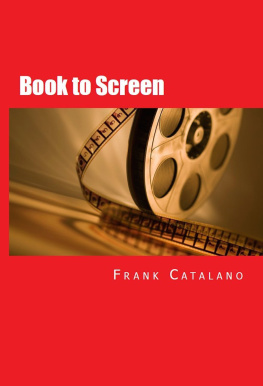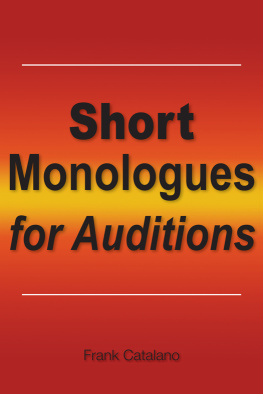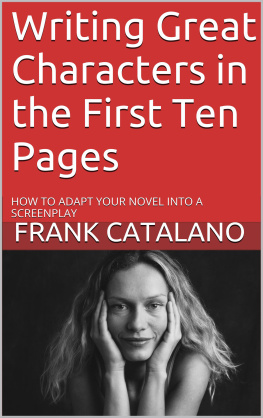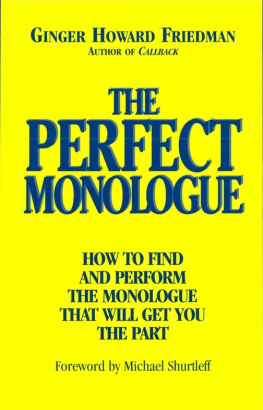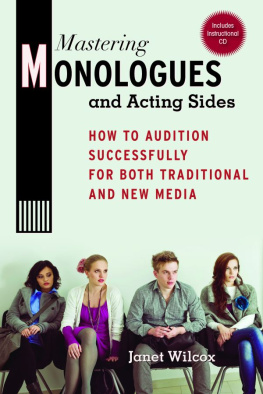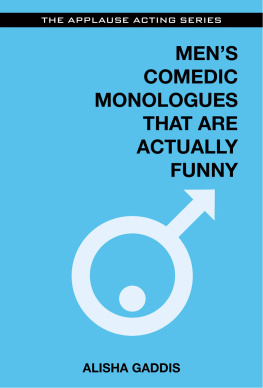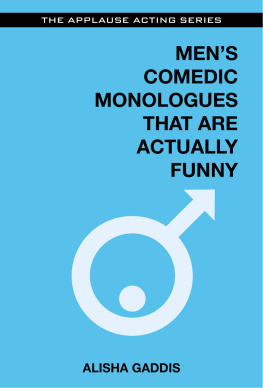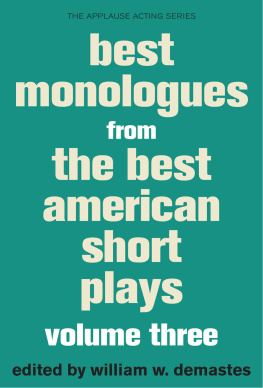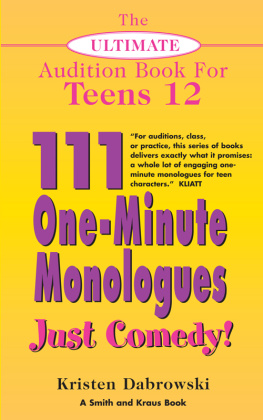
Copyright 2007, 2013 Frank Catalano
All rights reserved
ISBN: 1-4196-6834-X
ISBN-13: 9781419668340
eISBN: 9781625171160
Library of Congress Control Number: 2008908326
FORWARD
I have had the opportunity to teach acting for stage and camera over twenty years. During this time, I have always found it a challenge to find one comprehensive monologue textbook which contained the appropriate performance materials for college level students. Many of the existing texts contain selections from well-known staples of American and European drama. Other texts are compilations of materials written specifically as individual monologues geared more toward auditions than performance. I often suggest at the beginning of each semester that students purchase texts from a list of recommended but not required paperbacks so that they would have the best possible sources of material to meet their particular needs and to fully participate in the class. The problem with this scenario is that it is not cost effective for students to purchase a group of text books that they may or may not use during the course of the semester. In most Beginning classes specific monologues are assigned. However, at the Intermediate and Advanced level, the students want to have the ability to select material. This is often easier said than done because students often start one monologue and then abandon it for another. The end result, is that many students spend an inordinate amount of time pouring over the various texts researching and selecting material. Many times assignments due dates are often presented unprepared with the excuse: I couldnt find anything that was right for me. Many classes use improvisation to build student skill levels, inspire confidence and encourage creativity in performance.
The difficulty here is that many students (despite skill level) have the tendency to confuse improvisation with trying to be funny. Instead of focusing on the who, what, when and whereof a particular improvisation, they try to come up with the funniest lines or gestures. This can make for a wonderfully creative and fun class, but it also alienates those students that are not as adept with one liners as others. So while I do encourage the use of improvisation as a means to inspire creative choices, I feel the sooner students become familiar with handling varied types of scripted materials, the better. I enable them early on, to acquire interpretive skills and face the apprehension of memorization. The use of the monologue is a great way to start.
CLASSROOM/STUDIO TEXT
The individual pieces contained in this monologue volume or the parallel scene volumes are not created as part of any larger written well known body of work with linear plot lines. The construction here is compartmental with each piece existing on its own but connected thematically to the other 51. This type of construction allows both the instructor and the student the greatest amount of flexibility toward interpretation and performance. Students are encouraged to focus on the particular moments at hand and create a compelling reality within the parameters of each piece. In addition, each monologue has been created with the acting studio in mind. Settings and props are minimal to simplify the production requirements of each piece. The goal is for the student to focus on the particular acting requirements of each piece without the distraction of attempting to produce the technical aspects of a scene.
This collection of monologues when used as a classroom/studio text can easily be accessed by genre, gender and age range. Attributes are approximate suggestions based upon the individual subjects and point of view of each monologue. In addition, students may select monologues by a particular acting objective, emotional attribute, singing, movement or dialect. These identified attributes make it easier for a particular student to work on a specific area of their craft.
THEATRICAL PRODUCTION
This volume may also be used as a full length script for presentation as theatrical production with the title FIFTY TWO PICKUP. The monologues both verse and prose are connected thematically as parts of life and time jumbled together like a deck of cards. Fifty-two cards in a deck and fifty-two weeks in a year of a life. The material is so arranged that any number of actors can be assigned specific monologues. I have included in the text a sample breakdown by gender and age for a cast of six. However, it can be divided any number of ways to accommodate a particular class or group of students. The instructor or director is not forced with those tough decisions of whom to cast in the lead role. Every actor in the class or group will be able to perform in accordance with their skill level while being part of the overall production. The material is designed to be presented within almost any staging configuration (Proscenium, Thrust or Round) with minimal props and set. Optional title placards can be presented before each monologue. Certain monologues are related by character or plot lines to allow for advanced students to create a larger character arc. These associated monologues are indicated in the MONOLOGUE ATTRIBUTES section of the text.
AUDITION MATERIAL
Lastly, the material in this volume may also be utilized as audition material. Some of the monologues are no longer than one minute in length and are designed to do on the spot with little or no physical preparation in an audition setting. The actor may choose the material by GENDER AND AGE RANGE. This will provide the casting personnel or agent the opportunity to see the actor perform material that is exactly the right fit for their particular casting type. The material can be presented as both contemporary and period formats. It is available in both prose and verse to offer casting personnel a fresh new set of material rather than the monologues they have heard so many times before. This fresh new approach will allow them to focus in on the performers talent rather than have them compare an actors particular performance with another actor who performed the same material.
HOW TO USE THIS BOOK
Use this book as both a reference source and work book. As a reference source, you may use any number of the monologues contained here as a source for studio work, audition material and for full performance opportunities. The Monologue Attributes section of the text will assist you in selecting the appropriate material for your particular needs.
As a workbook, this volume may be used to explore the intellectual, emotional and physical attributes of a monologue. Each monologue line is numbered in the left hand column of the page. The right hand column of each monologue has space lines so that each beat may be marked to indicate a specific intellectual, emotional or physical action. I encourage you to use the lined spaced and numbered portions of these pages to make personal notes, mark beats and make any marks that may assist you in creating the most compelling monologue performances you can imagine.
Monologue Assignment Sheets (Addendum #9)
Monologue Assignment sheets useful tools to assist actors in specifying particular goals for a class assignment, audition, or performance. As a studio tool, Assignment Sheets may be handed in to the class leader or teacher at time of performance. This will provide the teacher with a universal tool to identify the students goals and choices made for the assignment. In addition, it is a useful tool for the teacher to make notes for student improvement and artistic growth.
WHAT IS A MONOLOGUE?
Next page

